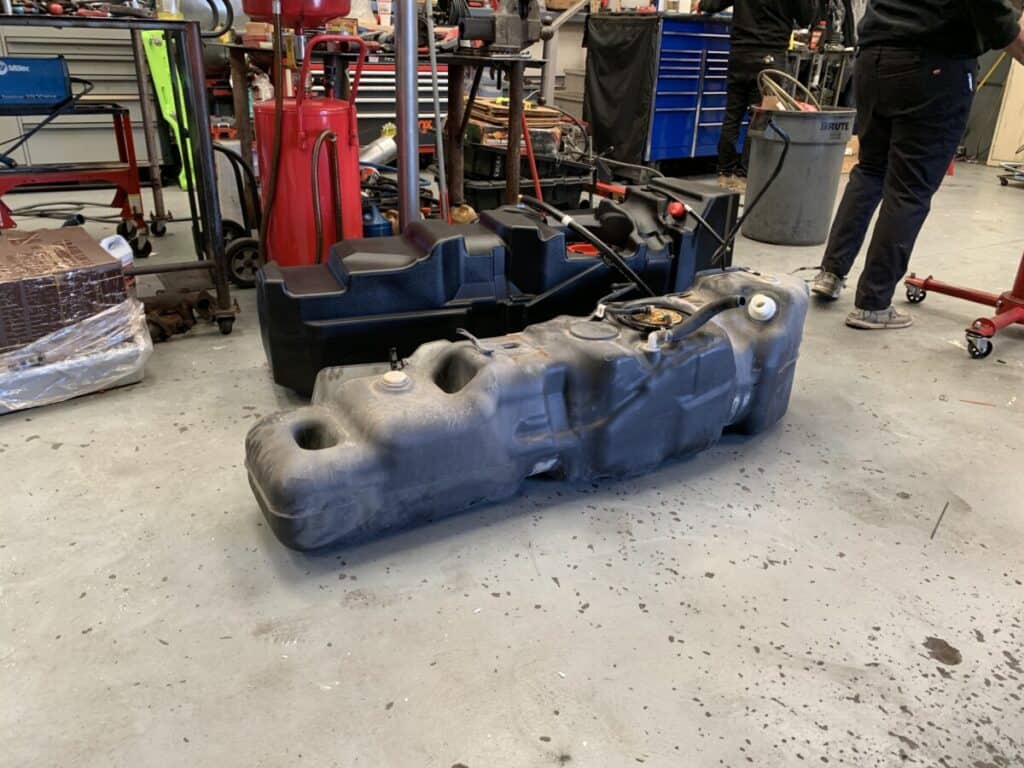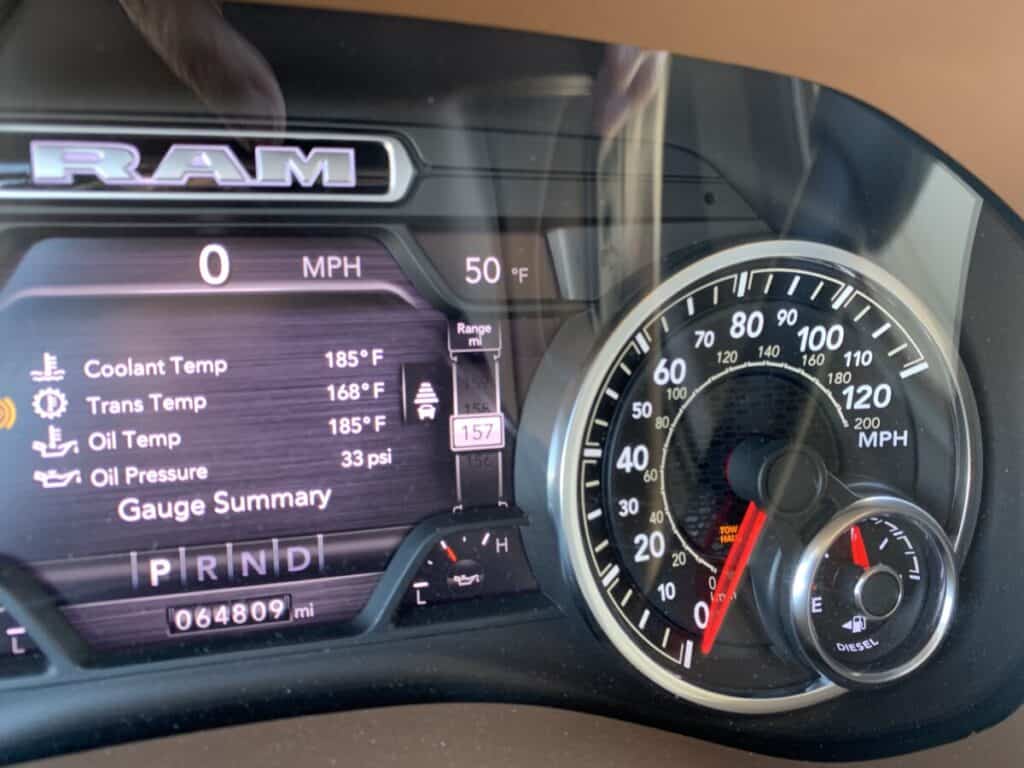
Before you go, check this out!
We have lots more on the site to show you. You've only seen one page. Check out this post which is one of the most popular of all time.
My wife and I are full time RVers and we pull a 30 foot Airstream Classic that weighs roughly 9,000 pounds. We don’t expect great mileage, of course, so we were prepared to stop frequently for fuel and simply wrote off the delays as the cost of doing business. Then, we started looking for a way to increase the time between fuel stops.
If the load and tow vehicle’s miles per gallon do not change, how do you increase the tow vehicle’s range?
If there are no significant changes to the gross combined vehicle weight and the fuel efficiency of a tow vehicle, increase the tow vehicle’s range by replacing the stock fuel tank with a larger one.
Our 31-gallon fuel tank allows us to wander about 275 miles down the road before stopping for fuel while towing. We can go farther when not towing, of course. Our overall length is roughly 52 feet, so we fill the diesel tank in the truck lanes at truck stops. There are advantages and disadvantages for us to stop there.
First, we tow with a Ram 2500 diesel and the truck lanes have fast flow nozzles. So, we can fill up faster in a truck lane than we can at the auto island. That assumes that we can fit and maneuver through the auto lanes, of course. The downside to fueling in the truck lanes is that we often have to wait in line a long time before getting to the pump.
Tractor-trailers can take a long time to fuel. The tractor can hold up to 300 gallons and even with fast flow nozzles, it can take a few minutes to fill them. If the driver needs DEF (diesel exhaust fluid) or if they are pulling a reefer trailer that also needs diesel, it can take a long time for a truck to clear the pump.
Common courtesy in the truck lane is to pull your rig past the pump when finished fueling so the person behind you can pull into the pump and start filling their rig. It is common to see a line painted in the parking lot so drivers know where to stop. From there, the driver will park the tractor-trailer and go inside to get their receipt, buy snacks, take a bio-break, and take care of any other business.
The entire process for one truck can take quite a while. When there are a couple of trucks in front of is, it is not unusual for us to spend up to an hour at a truck stop to fuel.

We travel using the 3-3-3 rule, which is like the trifecta of travel planning – cover no more than 300 miles in a day, arrive at your destination before 3 pm, and stay for 3 days. It’s like the travel version of “Goldilocks and the Three Bears” – not too much, not too little, but just right.
With a tank that limits our range to about 275 miles, we can expect to fuel twice on a travel day. With up to an hour at each stop, a lot of our travel day can be spent waiting in line and it can threaten our arrival target of 3 pm.
The thought of replacing our stock 31-gallon tank with an aftermarket 52-gallon tank didn’t cross our minds at the beginning of our full-time adventure. We looked forward to frequent stops at first because we could take bio-breaks, grab breakfast burritos and coffee, lunch and snacks, and stretch our legs.

The frequent stops are not as appealing after a year of experience. Now, we have a problem to solve.
How do we increase the fuel-carrying capacity of our tow vehicle and reduce the delays in our travel day? Our options include:
We planned routes through southwest Texas and New Mexico and assumed that there would be long stretches of highway where diesel was not available, so we carried two, five-gallon Jerry cans for several months as a reserve. There were a couple of instances traveling along that route where we needed to transfer fuel from our reserve, so carrying the cans was the right choice.
Jerry cans are nice to have, but they are inconvenient. They weigh between 35 and 40 pounds when full and must be moved from the bed, then hoisted high enough to drain the fuel into the tank. Our Jerry cans got dirty over time and they sometimes leak a bit, so I had to wash up after refueling. Transferring 10 gallons of fuel takes a little time so our travel was still delayed. Jerry cans take up room in the truck bed and because we travel full time, space in the bed is a valuable commodity.

I wanted to create more space in the bed and reduce the number of extra fuel stops so, we chose to replace our 31 gallon stock fuel tank with an aftermarket 52 gallon tank (I assume 48 gallons of usable fuel). Auxiliary fuel tanks and bladders were non-starters for me because they take up too much space in the bed. The benefits to replacing our stock fuel tank with a larger one includes:
There are cons to replacing a stock fuel tank with a larger one. They include:

The Distance to Empty algorithm calculates how far you can drive based on fuel level and driving patterns. But the mileage displayed is an estimate and changes quickly. I often compare DTE to the distance remaining on our trip and assume that I will not need to stop for fuel because my range was more than 100 miles farther than my destination. Then over a short time, I watched as the DTE range fell below the mileage to my destination.
My tank’s manufacturer pointed out that if I use my stock sending unit, my fuel gauge will report correctly. Since I don’t rely heavily on my DTE, I chose not to attempt adjusting the tank capacity in my truck’s configuration. I’ll continue to monitor my fuel gauge just as I did before the tank replacement.
Upgrading to a larger fuel tank increases our range on travel-day. It reduces the time we spend in line at truck stops and gives us more choices on where to stop. The downsides related to cost and weight are not an issue for us.
Anyone that spends a lot of time on the road should consider how much easier travel will be with a larger fuel tank. If you want to spend more time enjoying the journey, consider replacing your existing fuel tank with a larger one.
See you down the road!
NomadicNeighborhood is a participant in the Amazon Services LLC Associates Program, an affiliate advertising program designed to provide a means for sites to earn advertising fees by advertising and linking to Amazon.com. We also participate in other affiliate programs which compensate us for referring traffic.
How to Empty a Composting Toilet: Legal considerations and more
Composting toilets divert liquid and solid waste into separate tanks, and each must be emptied independently. Liquid waste is dumped into dump stations, vault toilets, or flush toilets. Solid...
Empty a Black Tank: 16 Steps That Include a Test and Preconditioning
[wpcode id="2133"] When I first started RVing, it took me close to an hour to empty the black and gray tank. I was learning and didn’t want to make a mess, so I took my time. As I gained more...